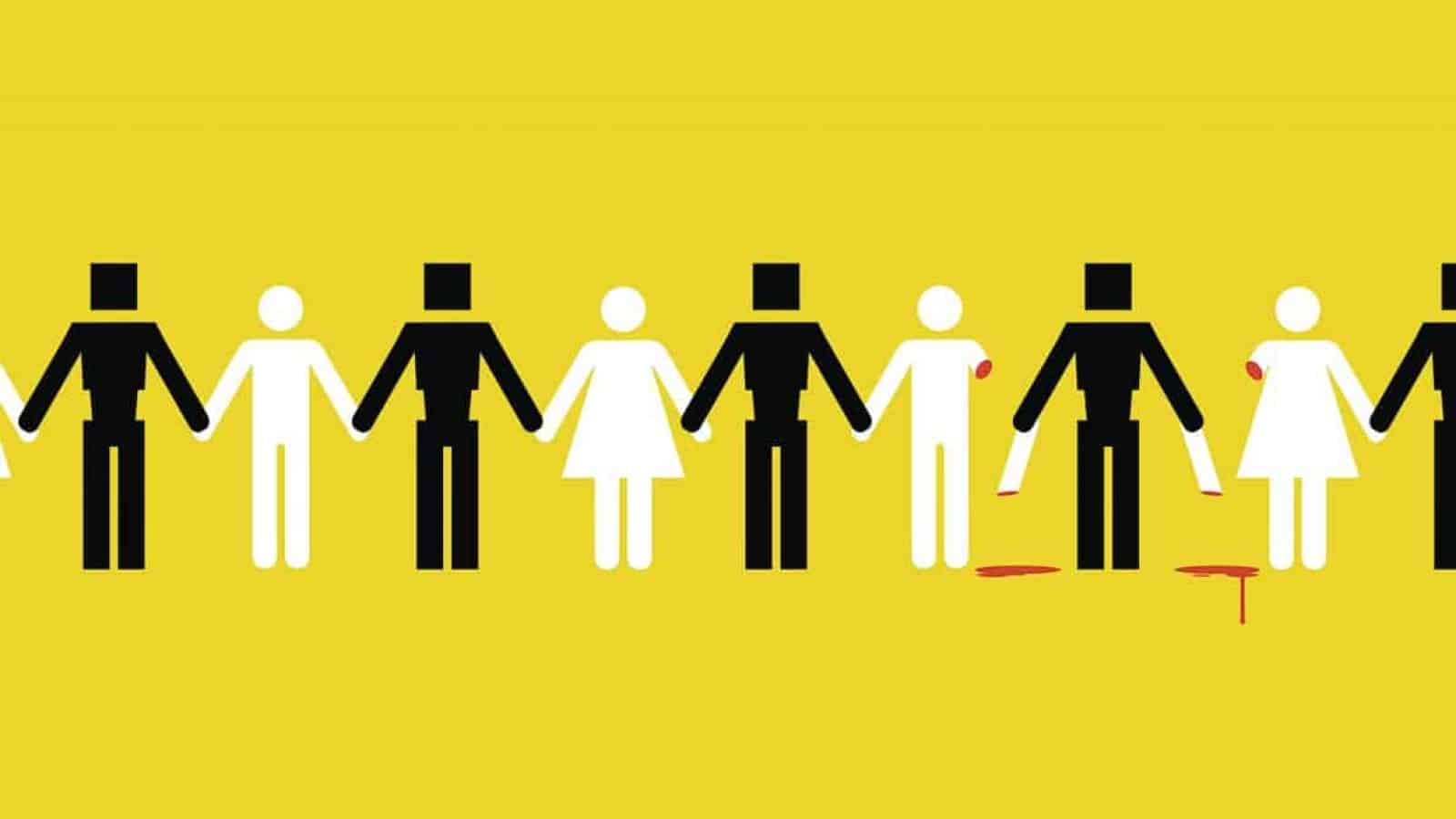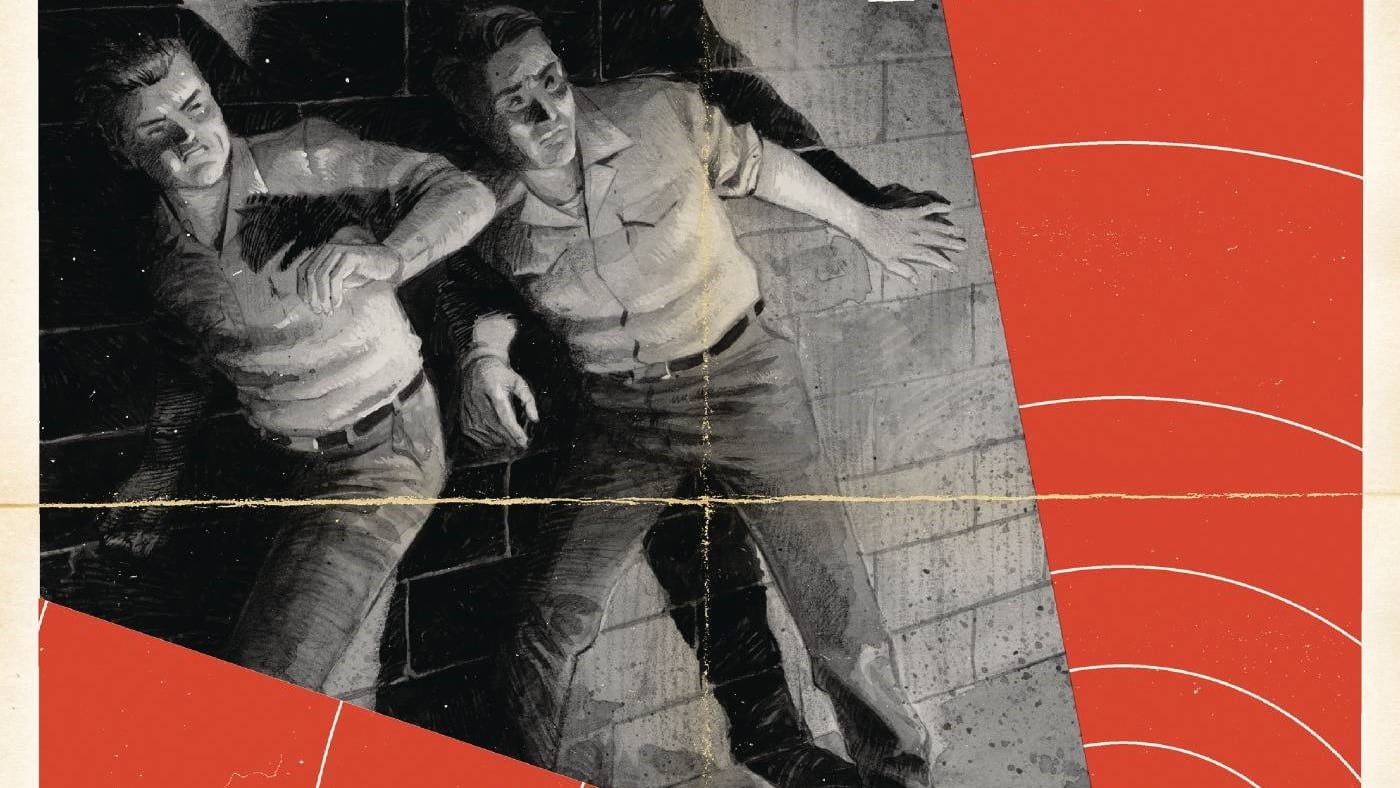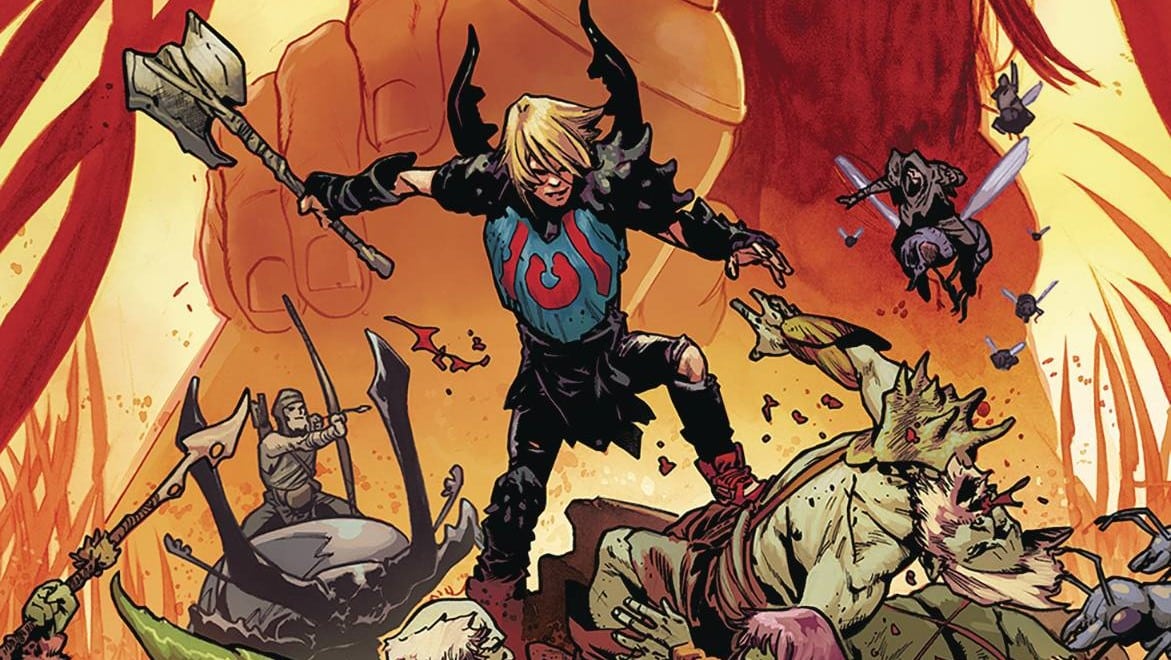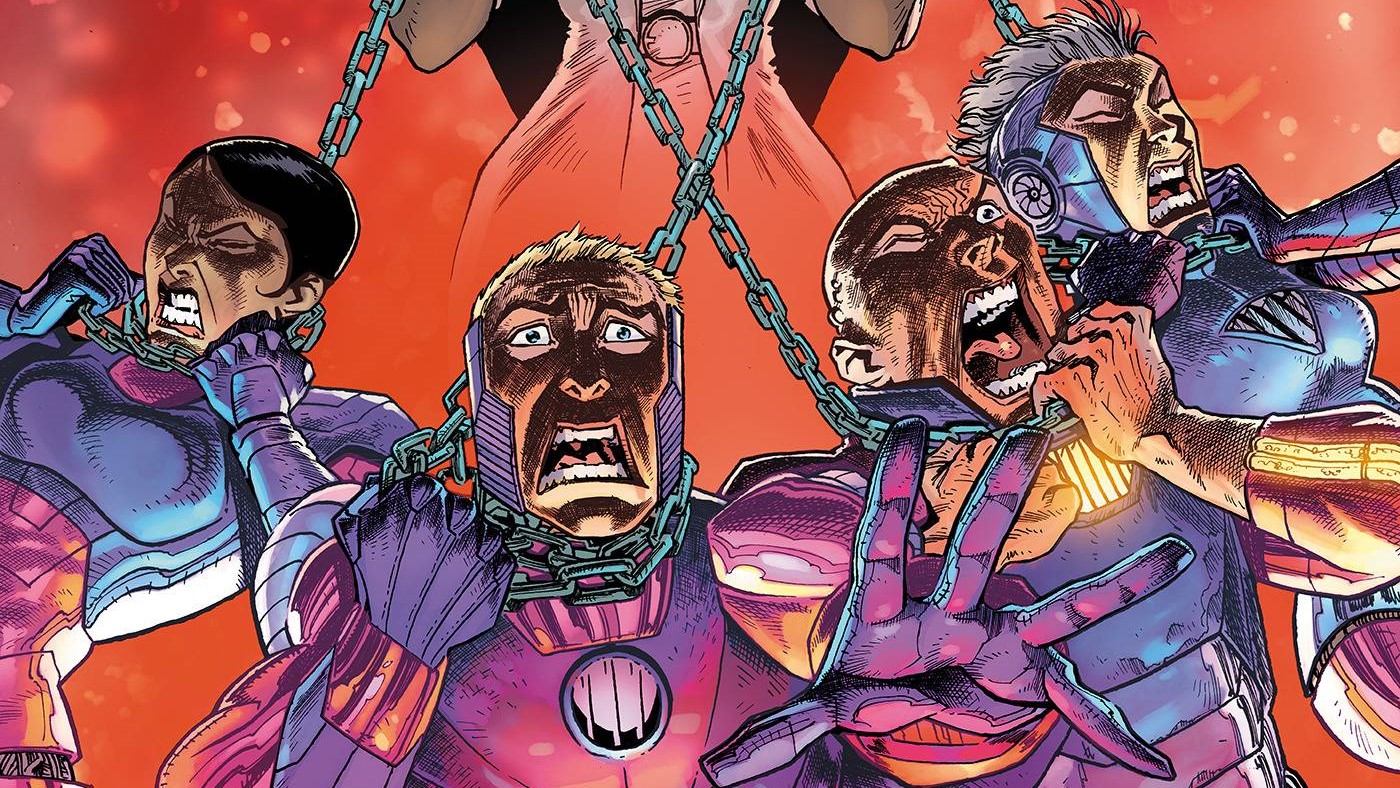The issue in which our girl Lulu gets strung up — and has the time of her life. Hit Me #4 is written by Christa Faust, drawn by Priscilla Petraites, colored by Marco Lesko, lettered by AndWorld Design and published by AWA.
Back to fuckin’ school? Already? To Hell with this. It’s Grimm Tales of Terror Quarterly: Back to School, with a thread story written by David Wohl and Dave Franchini, drawn by Massimiliano La Manna and colored by Walter Pereyra; “Don’t Be Afraid,” written by Franco Giacomarra, drawn by Alessandro Uezu and colored by Juan Manuel Rodriguez; “Fitcher’s Egg,” written by Dan Bookbinder, drawn by Allan Otero and colored by Maxflan Araujo; “The Flayer,” written by R. Honor Vincent, drawn by Massimiliano La Manna and colored by Leonardo Paciarotti; “Hell Night,” written by Max Robinson, drawn by Eduardo Garcia and colored by Maxflan Araujo; all lettered by Taylor Esposito and published by Zenescope.
When the metal ones come for you. Not All Robots #2 is written by Mark Russell, drawn by Mike Deodato Jr., colored by Lee Loughridge, lettered by Steve Wands and published by AWA.
Will Nevin: Can you believe this is our 20th indie leftover rodeo? Time flies when you’re reading books no one else gets to around here. And I know we’ve talked about this before, but Newburn has to be our Freshest Chicken to Date, right? Do you have anything maybe right up there with it? I’ve got one, and it’s totally not one we’re reading this week, nope, not at all. But for argument’s sake, what have been some of your other winners?
Ian Gregory: For me it’s probably Hit Me, but to be honest we’ve read so many series for this column that I hate to go back and take a look to remind myself. I’m also a fan of Slumber, Little Monsters, and those Wrong Earth spin-offs. We’ve had some good luck with these comics, Will.
Will: I’m so glad you mentioned Hit Me because in honor of maybe, possibly our Second Freshest Chicken, we’ve got an AWA sandwich this week, starting with Hit Me, concluding with Not All Robots and featuring in the middle the grindhouse-iest of books. Ready to ride?
Ian: Hit me.
Hit Me #4: It’s a Good Fucking Book

Will: I want to start with the art here. First, I thought the body suspension scene looked incredibly realistic — if that wasn’t based on some research, I’d be surprised. Second, the diametrically opposed character designs of Sadist Lo and Lulu were a great touch, with one covered in as much white material as possible while the other wears only enough black to satisfy a PG-13 rating (that the comic wouldn’t possibly be able to keep). The page that explains why they’re not a good kink connection is great too with its mirrored layout.
Ian: Once again, Hit Me has done so much with its premise. Sadist Lo and Lulu as mirrored pairs is a fantastic conceit, and one that works because they possess serious professional respect for each other, despite their differences — see how Lo smirks when Lulu doesn’t react to a cigarette being burnt on her mouth. There’s a lot more nuance to their relationship than would be strictly necessary, and I think it shows the care that has gone into making this book work. Artistically, as you say, this was a great issue. Hit Me has lots of sex in it, but it doesn’t feel exploitative or cheap. It also doesn’t go too far in the other direction and try to make everything painfully un-sexy. That’s a hard balance, but I think the team has done a good job of it so far.
Will: This has been and continues to be a great exploration of kink, and like I said, I really appreciated that discussion of why masochist Lulu and sadist Lo aren’t a great fit — just because someone is kinda sorta in the area that does it for you doesn’t mean that they themselves will do it for you.
Ian: I’m definitely interested in the way that organized crime and sex work have been depicted as having a symbiotic relationship. Sadist Lo doesn’t just do sex work but is also the torturer for the … Triads, I think? In any case, everything has tied together very neatly — Hit Me gives the impression of a wider world, filled with interesting characters, without getting lost in exposition. It’s also done a good job of giving Lulu opportunities to leverage her key advantages — her connections, determination and sheer pain tolerance.
Will: The pain tolerance alone is impressive enough. Anyone puts a ciggy out on Will’s tongue and he’s d-o-n-e. I presume this has a happy ending, right? The dude in distress gets rescued, all the ethically responsible people get off and we go home happy, right?
Ian: I’m glad that Danny hasn’t been totally forgotten in the background, but I’m definitely mostly along for the ride to see how Lulu gets Danny back, gets the Triad their diamonds and makes it out alive. I definitely can’t read how this series is going to end, and I’m really glad of that. I think it’s pretty rare to get to the penultimate issue of a series and still have no idea exactly how everything is going to shake out.
Grimm Tales of Terror Quarterly: Back to School: Exciting as School in the Summertime

Will: So, Ian, ages ago, publisher Zenescope put out a monthly(ish) book titled Grimm Tales of Terror. It was a simple, guilty pleasure of mine, a satisfying enough anthology of traditional horror morality plays. Quality was … a bit spotty, sure, but it was a fun read late at night under the covers. Now, the title exists as themed quarterly specials, and I believe it to be a bit worse with the format change. Or maybe it’s this particular book? Whatever it is, four stories set in/around a high school did not hang together all that well. (Or maybe I just resented a “back to school” book in July.)
Ian: “Horror morality plays” is right. Maybe I was wrong to expect any real level of nuance, but these just felt overwhelmingly preach-y, and not even in an interesting way. This was like, grade-school “don’t think badly of other people” stuff. Any time it approached an interesting idea — like the third story, about the artist who demands respect but is negatively influenced by watching Jordan Peterson videos — it quickly moves away to something less compelling.
Will: From a narrative standpoint, I think the first story was probably the weakest — nothing all that memorable or impactful about a Faustian deal that goes sideways for someone. The middle two were a bit more interesting as more or less reflections on outcasts and victims of bullying … who then become bullies themselves? Not sure that I like that particular lesson there. Also, I could have done without the various derogatory references to female characters.
Ian: Look, Will, as the official column Youth, I wasn’t in high school that long ago. And still, reading these stories, I have to wonder: Were these authors ever in high school? Is this how they imagine The Youth talk? I suppose the idea was to leverage the high school setting into some unique horror premises, but the first story has basically nothing to do with high school, and the last one is, well, you know, A Mess. The middle two did seem to ostensibly be about bullying, but they ended on such a weak note that I’m not actually sure what they were trying to say and what role high school played in the story.
Will: The final story … well, that one was just A Mess, an unidentifiable leftover, the sort of thing that gets double bagged before it goes in the trash. Ian, I swear that monthly book was fun and not terrible.
Ian: The last story felt like we were missing 10 pages from the beginning. Everyone’s mad at this woman for something she’s done, except that no one has told us what it is everyone’s mad about. It’s just her getting freaked out by spoooooky visions for six pages, and then she dies. Woo.
Not All Robots #2: Friendly Murder Disagreements Abound

Will: Finally, we’re concluding this week with Not All Robots #2 because 1) Boss Man Dan and Nola Pfau covered the first issue (or was it Dan-o-Tronic and NO-BOT?) and 2) the book pulled Eisner nominations for Best New Series and Best Humor Publication. Of course, I contend the Eisners are pointless because Ice Cream Man has never received a nomination and neither have I. (I’m sure that last thing has nothing to do with my position.)
My fragile ego aside, this is a good book — or at least the first two issues are. We see a world in which sentient robots have become both the main source of labor and household income, leaving humans displaced and unsure of their purpose. Robots are scared of people, people are scared of robots, and by the end of this issue, both sides are preparing for armed conflict. Russell, as the best satirist in comics currently, is using this story to critique white male privilege and how it’s harmful to everything it touches, and I found two points to be especially good: when the robot accused of killing an entire city full of humans is found not guilty in seconds (What? The justice system doesn’t work?!) and when our featured father, who’s hooked on “Bot News,” sympathizes with his family’s robot rather than his wife and children.
Also, the move to simply change robot names to something less menacing (“Razorball,” for example, becomes “Snowball”) really speaks to our current inability to do a goddamned substantive thing for gun control.
Ian: Do you ever wonder if metaphor has gone too far? Some elements of Not All Robots are instantly recognizable from our own society — such as a robot murdering his own family, then talking to the robot cops and having the murders covered up, or the way that the talk show has a human they literally refer to as the “token human.” Other parts, though, are more confusing. Humans are essentially the pets of robots in this setting, disallowed from work because of their inefficiencies. Are the robots… capitalism? Racism? Are they just robots? A lot of this humor isn’t working for me because I simply can’t tell where it’s aimed, and what I’m supposed to be laughing at.
Will: This story in general reminds me of Russell’s work on The Flintstones. There, we had the same dehumanization of the anthropomorphized dino tools and appliances, but the trauma (Fred and Barney’s service in the war) was different. I’d say if anyone liked that book, they’d like this one.
Ian: Even after two issues, it still feels like we’re doing setup for this story. We’ve seen lots of societal and philosophical conflict, but our main characters are only now getting involved in their own conflicts. I’ll stick around for a little longer to see where things go, but I hope things kick into gear soon.
Will: And, finally, the art. I am a sucker, once again, for Deodato’s work.
Ian: There’s a kind of photographic quality to the art that suits the robotic theme. It’s well done, but not for me personally.
Does This Smell OK?
- Rapid fire questions:
- Which comic book character is secretly the kinkiest?
- Will: Flash. Suspiciously wholesome.
- Ian: Wildcat. You’d never suspect those Justice Society guys.
- What’s your deal with the devil?
- Will: Bargained for more time to read comics not realizing I’d have to review/podcast everything I read. OH NO!
- Ian: I sold my soul to the devil to write comic reviews for a moderately popular website.
- Will: Shoulda bargained for The Beat, friendo!
- Evil robot name?
- Will: Happy Time Murder Machine
- Ian: Smotherboard
- Will: Fuuuuuck that’s a good one.
- Which comic book character is secretly the kinkiest?
- Special Effects Watch: The “FFFssss” as a cigarette gets extinguished on Lulu’s tongue is done up like a fading smoke cloud. It’s neat.
- The word balloon progression of a character’s injuries in Grimm Tales of Terror that went from “broken collarbone” to “coma” to “on life support” was weird and awkward.
- The fact that people are depraved enough to make hard seltzer out of leftover hot dog water kinda makes me want to die.
- Registered dietitian Phyllis J. Molnar has some summertime food safety tips, but it seems like most of ’em boil down to “throw away your picnic leftovers, weirdo.” Good advice, Phyllis.







